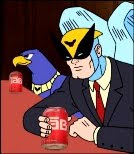I've never been a particular fan of It's a Wonderful Life. It's the kind of feel-good sappy movie that just doesn't do it for me. I don't hate it. I just don't get weepy about it like lots of other people do. But maybe that's because I've never looked at it through this guy's eyes:
“It’s a Wonderful Life” is a terrifying, asphyxiating story about growing up and relinquishing your dreams, of seeing your father driven to the grave before his time, of living among bitter, small-minded people. It is a story of being trapped, of compromising, of watching others move ahead and away, of becoming so filled with rage that you verbally abuse your children, their teacher and your oppressively perfect wife. It is also a nightmare account of an endless home renovation.It gets better:
Take the extended sequence in which George Bailey (James Stewart), having repeatedly tried and failed to escape Bedford Falls, N.Y., sees what it would be like had he never been born. The bucolic small town is replaced by a smoky, nightclub-filled, boogie-woogie-driven haven for showgirls and gamblers, who spill raucously out into the crowded sidewalks on Christmas Eve. It’s been renamed Pottersville, after the villainous Mr. Potter, Lionel Barrymore’s scheming financier.After all this, the writer still claims to love the film, but not for the reasons everybody else does. Which is fine, but I suspect he may be trying to have it both ways.
Here’s the thing about Pottersville that struck me when I was 15: It looks like much more fun than stultifying Bedford Falls — the women are hot, the music swings, and the fun times go on all night. If anything, Pottersville captures just the type of excitement George had long been seeking.
For what it's worth, I think the film would have been immensely helped if Capra had used the alternate ending:





1 comment:
I've never thought of it that way before.
Post a Comment